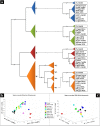Through-container, extremely low concentration detection of multiple chemical markers of counterfeit alcohol using a handheld SORS device
- PMID: 28935907
- PMCID: PMC5608898
- DOI: 10.1038/s41598-017-12263-0
Through-container, extremely low concentration detection of multiple chemical markers of counterfeit alcohol using a handheld SORS device
Abstract
Major food adulteration incidents occur with alarming frequency and are episodic, with the latest incident, involving the adulteration of meat from 21 producers in Brazil supplied to 60 other countries, reinforcing this view. Food fraud and counterfeiting involves all types of foods, feed, beverages, and packaging, with the potential for serious health, as well as significant economic and social impacts. In the spirit drinks sector, counterfeiters often 'recycle' used genuine packaging, or employ good quality simulants. To prove that suspect products are non-authentic ideally requires accurate, sensitive, analysis of the complex chemical composition while still in its packaging. This has yet to be achieved. Here, we have developed handheld spatially offset Raman spectroscopy (SORS) for the first time in a food or beverage product, and demonstrate the potential for rapid in situ through-container analysis; achieving unequivocal detection of multiple chemical markers known for their use in the adulteration and counterfeiting of Scotch whisky, and other spirit drinks. We demonstrate that it is possible to detect a total of 10 denaturants/additives in extremely low concentrations without any contact with the sample; discriminate between and within multiple well-known Scotch whisky brands, and detect methanol concentrations well below the maximum human tolerable level.
Conflict of interest statement
The authors declare that they have no competing interests.
Figures



Similar articles
-
Rapid through-container detection of fake spirits and methanol quantification with handheld Raman spectroscopy.Analyst. 2018 Dec 17;144(1):324-330. doi: 10.1039/c8an01702f. Analyst. 2018. PMID: 30516175
-
Through-packaging analysis of butter adulteration using line-scan spatially offset Raman spectroscopy.Anal Bioanal Chem. 2018 Sep;410(22):5663-5673. doi: 10.1007/s00216-018-1189-1. Epub 2018 Jun 22. Anal Bioanal Chem. 2018. PMID: 29934851
-
Developing anti-counterfeiting measures: The role of smart packaging.Food Res Int. 2019 Sep;123:135-143. doi: 10.1016/j.foodres.2019.04.049. Epub 2019 Apr 25. Food Res Int. 2019. PMID: 31284961
-
Chemical composition analysis and authentication of whisky.J Sci Food Agric. 2015 Aug 30;95(11):2159-66. doi: 10.1002/jsfa.6960. Epub 2014 Nov 13. J Sci Food Agric. 2015. PMID: 25315338 Review.
-
Raman spectroscopy coupled with chemometrics for identification of adulteration and fraud in muscle foods: a review.Crit Rev Food Sci Nutr. 2025;65(11):2008-2030. doi: 10.1080/10408398.2024.2329956. Epub 2024 Mar 24. Crit Rev Food Sci Nutr. 2025. PMID: 38523442 Review.
Cited by
-
Low-Cost Raman Spectroscopy Setup Combined with a Machine Learning Model.Sensors (Basel). 2025 Jan 23;25(3):659. doi: 10.3390/s25030659. Sensors (Basel). 2025. PMID: 39943297 Free PMC article.
-
Learning algorithms for identification of whisky using portable Raman spectroscopy.Curr Res Food Sci. 2024 Apr 1;8:100729. doi: 10.1016/j.crfs.2024.100729. eCollection 2024. Curr Res Food Sci. 2024. PMID: 38595930 Free PMC article.
-
Growth of Plasmonic Nanoparticles for Aging Cask-Matured Whisky.ACS Appl Nano Mater. 2022 Oct 28;5(10):15362-15368. doi: 10.1021/acsanm.2c03406. Epub 2022 Oct 6. ACS Appl Nano Mater. 2022. PMID: 36338330 Free PMC article.
-
Application of Spatial Offset Raman Spectroscopy (SORS) and Machine Learning for Sugar Syrup Adulteration Detection in UK Honey.Foods. 2024 Jul 31;13(15):2425. doi: 10.3390/foods13152425. Foods. 2024. PMID: 39123616 Free PMC article.
-
Selected Instrumental Techniques Applied in Food and Feed: Quality, Safety and Adulteration Analysis.Foods. 2021 May 13;10(5):1081. doi: 10.3390/foods10051081. Foods. 2021. PMID: 34068197 Free PMC article. Review.
References
-
- spiritsEUROPE A Spirit of Growth:Trade (2017a).
-
- spiritsEUROPE A Spirit of Growth: Jobs (2017b).
-
- Aylott, R. I. Analytical Strategies Supporting Protected Designations of Origin for Alcoholic Beverages (Elsevier B.V.) (2013).
Publication types
MeSH terms
Substances
LinkOut - more resources
Full Text Sources
Other Literature Sources
Medical
Molecular Biology Databases

